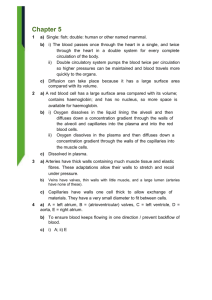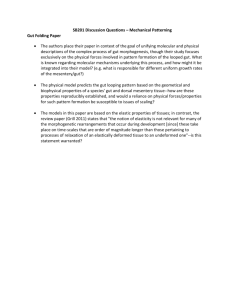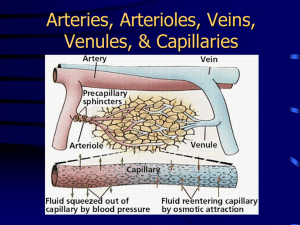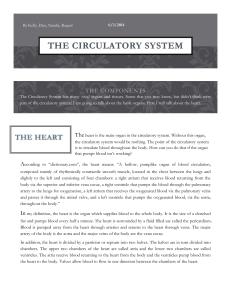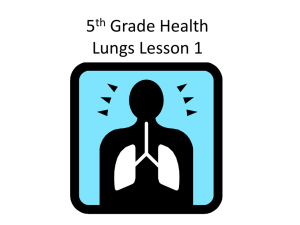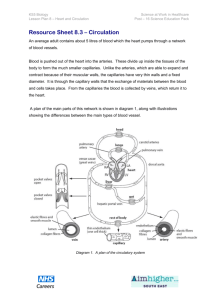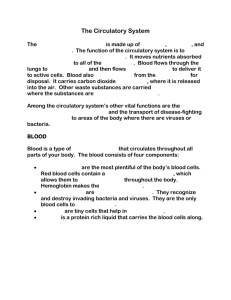Transport in Animals.Summary notes
advertisement
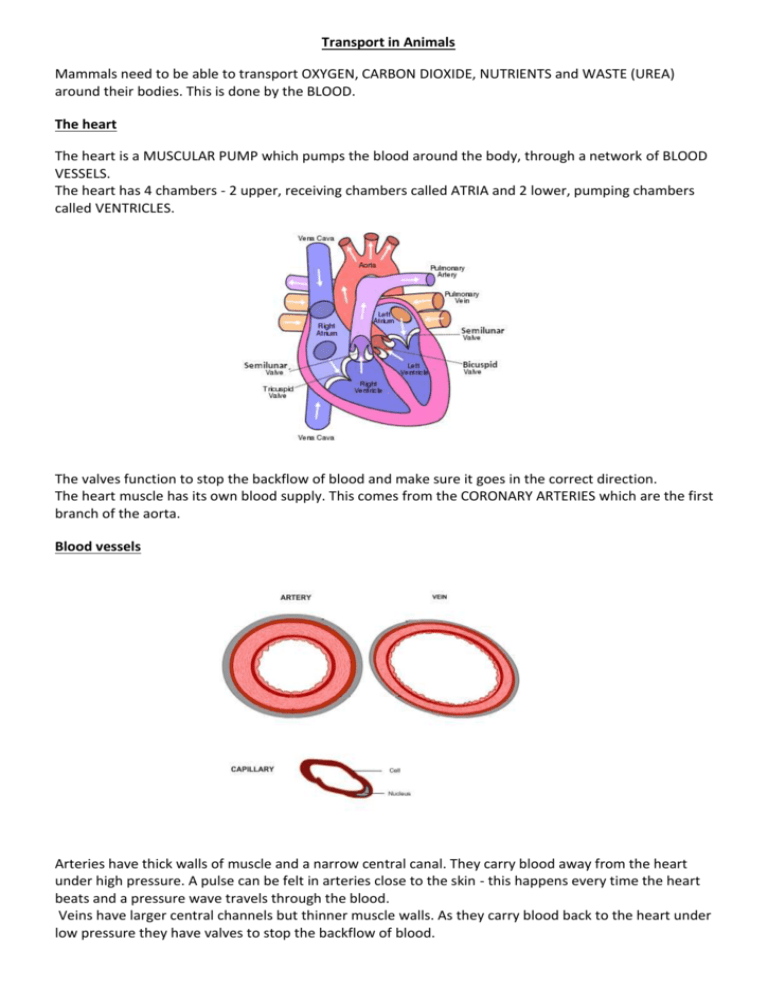
Transport in Animals Mammals need to be able to transport OXYGEN, CARBON DIOXIDE, NUTRIENTS and WASTE (UREA) around their bodies. This is done by the BLOOD. The heart The heart is a MUSCULAR PUMP which pumps the blood around the body, through a network of BLOOD VESSELS. The heart has 4 chambers - 2 upper, receiving chambers called ATRIA and 2 lower, pumping chambers called VENTRICLES. The valves function to stop the backflow of blood and make sure it goes in the correct direction. The heart muscle has its own blood supply. This comes from the CORONARY ARTERIES which are the first branch of the aorta. Blood vessels Arteries have thick walls of muscle and a narrow central canal. They carry blood away from the heart under high pressure. A pulse can be felt in arteries close to the skin - this happens every time the heart beats and a pressure wave travels through the blood. Veins have larger central channels but thinner muscle walls. As they carry blood back to the heart under low pressure they have valves to stop the backflow of blood. Capillaries are microscopic blood vessels that connect arteries and veins. They have one cell thick walls and are the site of exchange of materials like oxygen and food. Capillaries form a network in all the body's organs and run close to every cell of the body. They have a very large surface area which makes them efficient at their function. Red blood cells Red blood cells are BICONCAVE DISCS. This increases their SURFACE AREA which allows better uptake of oxygen. Red blood cells are filled with an IRON containing pigment called HAEMOGLOBIN. This molecule acts as an oxygen carrier and in the presence of oxygen it forms OXYHAEMOGLOBIN. Gas exchange in mammals. During RESPIRATION organisms require a constant supply of OXYGEN and need to get rid of the waste product CARBON DIOXIDE. For this reason mammals need to BREATHE to exchange oxygen and carbon dioxide between the body cells and the air. The lungs are the site of GAS EXCHANGE. They are found in the chest cavity or THORAX and are protected by the RIBCAGE. The trachea has many CARTILAGE RINGS that function to keep the airways open even when the head is moved in different directions. Gas exchange occurs in the ALVEOLI or AIR SACS. The walls of the alveoli are very thin and have a large surface area. The alveoli are surrounded by blood capillaries. This allows for easy DIFFUSION of gases. The trachea is lined with MUCUS PRODUCING GOBLET CELLS and CILIATED EPITHELIUM. The mucus traps dirt particles and microorganisms and this then carried upwards by the beating motion of the cilia, to the mouth. The mucus is then swallowed and any microorganisms are killed by stomach acid. Transport of food When food is swallowed it is moved through the gut by contraction and relaxation of muscles in the gut wall. This is known as PERISTALSIS. Muscles in the gut behind the food CONTRACT and muscles in the gut in front of the food RELAX. Food is pushed along the gut. The end products of digestion are absorbed into the blood stream in the small intestine which has many, tiny, finger like projections called VILLI. The villi have a very large surface area, a good blood supply and one cell thick walls. This makes them very efficient at absorbing digested food. The villus has a dense capillary network. Glucose and amino acids pass into them and are transported to the liver. The lacteal (lymphatic vessel) collects the products of fat digestion and passes them to the lymphatic system. Lifestyle choices and their effects on transport systems A diet high in fat and salt, excess alcohol intake, minimal exercise, smoking and high stress lifestyle all have negative effects on our health. Diseases such as lung cancer, heart disease, Type 2 Diabetes and stroke can be the result. Exercise is good for your health – it lowers your blood pressure and your heart rate as the heart is working more efficiently. The diseases caused by these unhealthy lifestyles cost the NHS a lot of money as we see people needing treatment for cancers, weight reduction surgery and injuries caused by excessive alcohol. Is it fair that these things should be free on the NHS?
